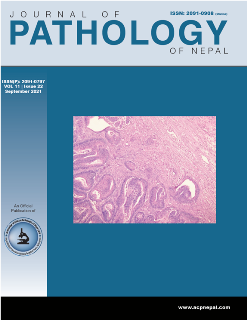Pattern of seminal fluid analysis in a male partner of infertile couple presented in infertility clinic of Patan hospital
DOI:
https://doi.org/10.3126/jpn.v11i2.41391Keywords:
Azoospermia, Infertility, Oligospermia, Sperm analysisAbstract
Background: Infertility is defined as the failure of a couple to conceive after one year of regular sexual intercourse. The malefactor is responsible for at least 50% of cases of failure to conceive. Semen analysis remains the cornerstone in the preliminary investigation of male factor infertility. This study aimed to evaluate seminal fluid parameters in the male partners of infertile couples.
Materials and Methods: This retrospective study was conducted in the Department of Pathology, Patan Academy of Health Sciences, Patan hospital, Nepal between December 2019 and January 2020. All the 243 specimens were processed and analyzed according to WHO guidelines on semen analysis.
Results: Present study included a total of 243 semen samples, aged between 20-63 years with a mean age of 32.0 years. Normozoospermia was observed in (26.3%). The most common abnormalities found in this study were asthenozoospermia (25.5%), oligospermia (19.3%), azoospermia (6.5%), and teratozoospermia.
Conclusions: Semen analysis remains a keystone in assessing male factor infertility in developing countries like Nepal. However, needs further evaluation to establish possible etiologies of male infertility.
Downloads
Downloads
Published
How to Cite
Issue
Section
License
Copyright (c) 2021 Dipti Gautam, Manisha Shrestha, Shiva Raj K.C.

This work is licensed under a Creative Commons Attribution 4.0 International License.
This license enables reusers to distribute, remix, adapt, and build upon the material in any medium or format, so long as attribution is given to the creator. The license allows for commercial use.




